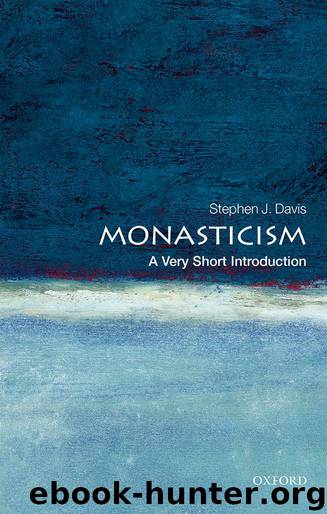Monasticism: A Very Short Introduction by Stephen J. Davis

Author:Stephen J. Davis
Language: eng
Format: epub
Tags: History, Monasticism, Religion, Rituals & Practice
ISBN: 9780191027345
Publisher: Oxford University Press
Published: 2018-01-12T03:00:00+00:00
Ascetic saints, spiritual combat, and the making of monks
Girard’s observations about the relationship between mimesis and violence may be extended further in light of how monastic narratives often portray the ascetic life as a form of spiritual combat. Saints held up as exemplars for monastic imitation are often portrayed as engaged in martial contests with human and non-human foes. We have already encountered the image of an early Christian desert father being equipped for battle with the armour (‘breastplate’) of God, and the Jain monk Sukosˊala achieving victory by allowing his body to be torn to shreds by a vicious tigress. What role does the representation of spiritual combat play in the Lives of holy figures, and how does this relate to the portrayal of saints as mimetic models for the monastic life?
In his scholarship on the early Christian ‘holy man’, Peter Brown provides a helpful set of tools for answering these questions. For Brown, the representation of saintly figures in the late Roman world was about the adjudication of social and spiritual power. The Lives of saints represent them in various roles, each of which sheds light on the way that they functioned as channels of divine potency and charisma. As miracle workers, holy persons make their power manifest in imitation of Christ. As arbitrators and mediators between God and humankind, holy persons hold the power to ‘lift the vengeance of God’ by removing the effects of a curse or exorcizing a demon. As strangers to society, they stand ‘outside the ties of family, and of economic interest’, and thus personify a kind of objective authority, similar to that of the ancient Greek oracles. As healers and confessors, they bring the divine near to human supplicants by offering cures and blessings. As patrons and friends of God, they sponsor an economy of gift exchange, serving as intercessors and ambassadors at the divine court on behalf of their faithful clientele and receiving their devotion in turn. As preachers of repentance, they hold sway over human hearts, ‘stirring [them] to contrition’. As privileged liaisons between the human and natural worlds, they calibrate the order and balance of the cosmos. Finally, as ascetic athletes, holy persons train their bodies into powerful vessels for the rigours of renunciatory existence, which sometimes takes the form of visceral, violent combat with demons and other opposing forces.
To get a more textured sense of the role that competition and combat play in the literary representation of saints as models for the monastic life, and how ascetic practice is portrayed as a venue for the exercise of spiritual power, let us turn to the biographies of two famous solitaries, one from late ancient Egypt and the other from medieval Tibet. The first is Anthony, the desert hermit and so-called ‘father of Christian monasticism’. The second is Milarepa, the revered Buddhist yogin and wandering teacher.
At the beginning of the Life of Anthony, its author Athanasius addresses his readers, praising them for having ‘entered on a fine contest with the
Download
This site does not store any files on its server. We only index and link to content provided by other sites. Please contact the content providers to delete copyright contents if any and email us, we'll remove relevant links or contents immediately.
| Clergy | Devotionals |
| Faith | Inspirational |
| Meditations | Monasticism & Asceticism |
| Prayer | Prayerbooks |
| Ritual | Sermons |
The Secret Power of Speaking God's Word by Joyce Meyer(2966)
More Language of Letting Go: 366 New Daily Meditations by Melody Beattie(2966)
The Holy Spirit by Billy Graham(2892)
To Light a Sacred Flame by Silver RavenWolf(2767)
Tuesdays With Morrie by Mitch Albom(2683)
The Lost Art of Good Conversation by Sakyong Mipham(2574)
The Traveler's Gift by Andy Andrews(2409)
Kundalini by Gopi Krishna(2135)
A Kingsbury Collection by Karen Kingsbury(2058)
Angels of God: The Bible, the Church and the Heavenly Hosts by Mike Aquilina(1932)
Finding Chika by Mitch Albom(1926)
Anxious for Nothing by Max Lucado(1907)
Angels by Billy Graham(1886)
As a Man Thinketh by James Allen(1861)
Curse Tablets and Binding Spells from the Ancient World by Gager John G.;(1836)
The Yoga of Jesus: Understanding the Hidden Teachings of the Gospels by Paramahansa Yogananda(1803)
Barking to the Choir by Gregory Boyle(1785)
Autobiography of a Yogi (Complete Edition) by Yogananda Paramahansa(1774)
How To Be Born Again by Billy Graham(1730)
